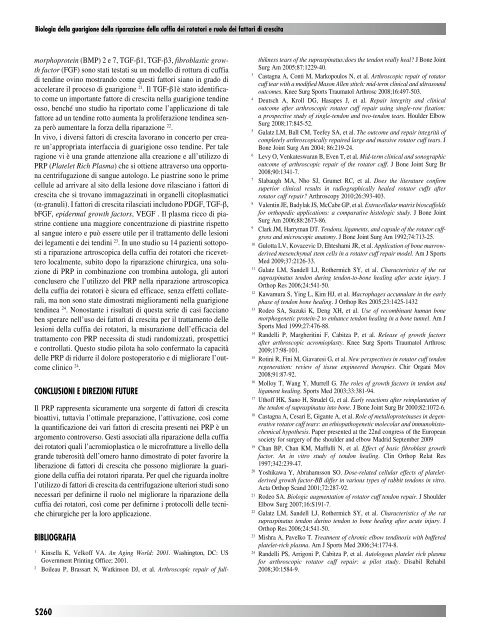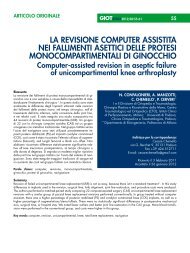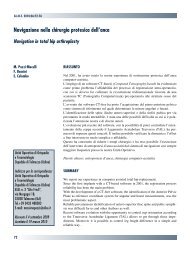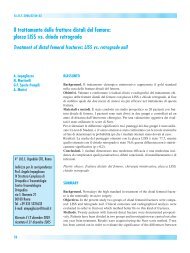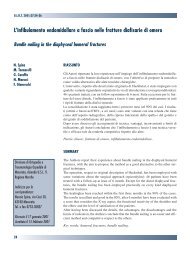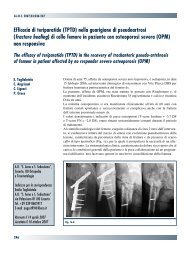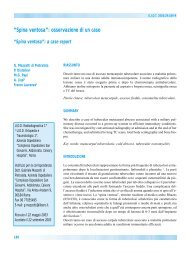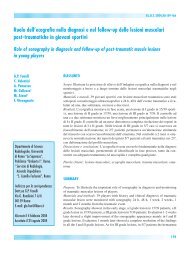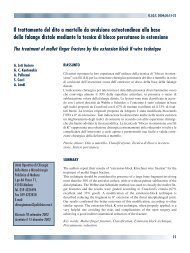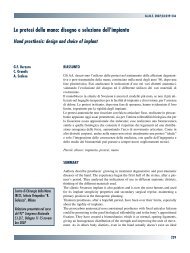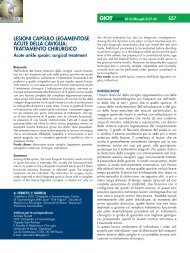30845 Suppl Giot.pdf - Giornale Italiano di Ortopedia e Traumatologia
30845 Suppl Giot.pdf - Giornale Italiano di Ortopedia e Traumatologia
30845 Suppl Giot.pdf - Giornale Italiano di Ortopedia e Traumatologia
You also want an ePaper? Increase the reach of your titles
YUMPU automatically turns print PDFs into web optimized ePapers that Google loves.
Biologia della guarigione della riparazione della cuffia dei rotatori e ruolo dei fattori <strong>di</strong> crescita<br />
morphoprotein (BMP) 2 e 7, TGF-β1, TGF-β3, fibroblastic growth<br />
factor (FGF) sono stati testati su un modello <strong>di</strong> rottura <strong>di</strong> cuffia<br />
<strong>di</strong> ten<strong>di</strong>ne ovino mostrando come questi fattori siano in grado <strong>di</strong><br />
accelerare il proceso <strong>di</strong> guarigione 21 . Il TGF-β1è stato identificato<br />
come un importante fattore <strong>di</strong> crescita nella guarigione ten<strong>di</strong>ne<br />
osso, benché uno stu<strong>di</strong>o ha riportato come l’applicazione <strong>di</strong> tale<br />
fattore ad un ten<strong>di</strong>ne rotto aumenta la proliferazione ten<strong>di</strong>nea senza<br />
però aumentare la forza della riparazione 22 .<br />
In vivo, i <strong>di</strong>versi fattori <strong>di</strong> crescita lavorano in concerto per creare<br />
un’appropriata interfaccia <strong>di</strong> guarigione osso ten<strong>di</strong>ne. Per tale<br />
ragione vi è una grande attenzione alla creazione e all’utilizzo <strong>di</strong><br />
PRP (Platelet Rich Plasma) che si ottiene attraverso una opportuna<br />
centrifugazione <strong>di</strong> sangue autologo. Le piastrine sono le prime<br />
cellule ad arrivare al sito della lesione dove rilasciano i fattori <strong>di</strong><br />
crescita che si trovano immagazzinati in organelli citoplasmatici<br />
(α-granuli). I fattori <strong>di</strong> crescita rilasciati includono PDGF, TGF-β,<br />
bFGF, epidermal growth factors, VEGF . Il plasma ricco <strong>di</strong> piastrine<br />
contiene una maggiore concentrazione <strong>di</strong> piastrine rispetto<br />
al sangue intero e può essere utile per il trattamento delle lesioni<br />
dei legamenti e dei ten<strong>di</strong>ni 23 . In uno stu<strong>di</strong>o su 14 pazienti sottoposti<br />
a riparazione artroscopica della cuffia dei rotatori che ricevettero<br />
localmente, subito dopo la riparazione chirurgica, una soluzione<br />
<strong>di</strong> PRP in combinazione con trombina autologa, gli autori<br />
conclusero che l’utilizzo del PRP nella riparazione artroscopica<br />
della cuffia dei rotatori è sicura ed efficace, senza effetti collaterali,<br />
ma non sono state <strong>di</strong>mostrati miglioramenti nella guarigione<br />
ten<strong>di</strong>nea 24 . Nonostante i risultati <strong>di</strong> questa serie <strong>di</strong> casi facciano<br />
ben sperare nell’uso dei fattori <strong>di</strong> crescita per il trattamento delle<br />
lesioni della cuffia dei rotatori, la misurazione dell’efficacia del<br />
trattamento con PRP necessita <strong>di</strong> stu<strong>di</strong> randomizzati, prospettici<br />
e controllati. Questo stu<strong>di</strong>o pilota ha solo confermato la capacità<br />
delle PRP <strong>di</strong> ridurre il dolore postoperatorio e <strong>di</strong> migliorare l’outcome<br />
clinico 24 .<br />
CONCLuSIONI E DIrEzIONI FuTurE<br />
Il PRP rappresenta sicuramente una sorgente <strong>di</strong> fattori <strong>di</strong> crescita<br />
bioattivi, tuttavia l’ottimale preparazione, l’attivazione, così come<br />
la quantificazione dei vari fattori <strong>di</strong> crescita presenti nei PRP è un<br />
argomento controverso. Gesti associati alla riparazione della cuffia<br />
dei rotatori quali l’acromioplastica o le microfratture a livello della<br />
grande tuberosità dell’omero hanno <strong>di</strong>mostrato <strong>di</strong> poter favorire la<br />
liberazione <strong>di</strong> fattori <strong>di</strong> crescita che possono migliorare la guarigione<br />
della cuffia dei rotatori riparata. Per quel che riguarda inoltre<br />
l’utilizzo <strong>di</strong> fattori <strong>di</strong> crescita da centrifugazione ulteriori stu<strong>di</strong> sono<br />
necessari per definirne il ruolo nel migliorare la riparazione della<br />
cuffia dei rotatori, così come per definirne i protocolli delle tecniche<br />
chirurgiche per la loro applicazione.<br />
BIBLIOGraFIa<br />
1 Kinsella K, Velkoff VA. An Aging World: 2001. Washington, DC: US<br />
Government Printing Office; 2001.<br />
2 Boileau P, Brassart N, Watkinson DJ, et al. Arthroscopic repair of full-<br />
S260<br />
thikness tears of the supraspinatus:does the tendon really heal? J Bone Joint<br />
Surg Am 2005;87:1229-40.<br />
3 Castagna A, Conti M, Markopoulos N, et al. Arthroscopic repair of rotator<br />
cuff tear with a mo<strong>di</strong>fied Mason Allen stitch: mid-term clinical and ultrasound<br />
outcomes. Knee Surg Sports Traumatol Arthrosc 2008;16:497-503.<br />
4 Deutsch A, Kroll DG, Hasapes J, et al. Repair integrity and clinical<br />
outcome after arthroscopic rotator cuff repair using single-row fixation:<br />
a prospective study of single-tendon and two-tendon tears. Houlder Elbow<br />
Surg 2008;17:845-52.<br />
5 Galatz LM, Ball CM, Teefey SA, et al. The outcome and repair integrità of<br />
completely arthroscopically repaired large and massive rotator cuff tears. J<br />
Bone Joint Surg Am 2004; 86:219-24.<br />
6 Levy O, Venkateswaran B, Even T, et al. Mid-term clinical and sonographic<br />
outcome of arthroscopic repair of the rotator cuff. J Bone Joint Surg Br<br />
2008;90:1341-7.<br />
7 Slabaugh MA, Nho SJ, Grumet RC, et al. Does the literature confirm<br />
superior clinical results in ra<strong>di</strong>ographically healed rotator cuffs after<br />
rotator cuff repair? Arthroscopy 2010;26:393-403.<br />
8 Valentin JE, Badylak JS, McCabe GP, et al. Extracellular matrix bioscaffolds<br />
for orthope<strong>di</strong>c applications: a comparative histologic study. J Bone Joint<br />
Surg Am 2006;88:2673-86.<br />
9 Clark JM, Harryman DT. Tendons, ligaments, and capsule of the rotator cuffgross<br />
and microscopic anatomy. J Bone Joint Surg Am 1992;74:713-25.<br />
10 Gulotta LV, Kovacevic D, Ehteshami JR, et al. Application of bone marrowderived<br />
mesenchymal stem cells in a rotator cuff repair model. Am J Sports<br />
Med 2009;37:2126-33.<br />
11 Galatz LM, Sandell LJ, Rothermich SY, et al. Characteristics of the rat<br />
supraspinatus tendon during tendon-to-bone healing after acute injury. J<br />
Orthop Res 2006;24:541-50.<br />
12 Kawamura S, Ying L, Kim HJ, et al. Macrophages accumulate in the early<br />
phase of tendon bone healing. J Orthop Res 2005;23:1425-1432<br />
13 Rodeo SA, Suzuki K, Deng XH, et al. Use of recombinant human bone<br />
morphogenetic protein-2 to enhance tendon healing in a bone tunnel. Am J<br />
Sports Med 1999;27:476-88.<br />
14 Randelli P, Margheritini F, Cabitza P, et al. Release of growth factors<br />
after arthroscopic acromioplasty. Knee Surg Sports Traumatol Arthrosc<br />
2009;17:98-101.<br />
15 Rotini R, Fini M, Giavaresi G, et al. New perspectives in rotator cuff tendon<br />
regeneration: review of tissue engineered therapies. Chir Organi Mov<br />
2008;91:87-92.<br />
16 Molloy T, Wang Y, Murrell G. The roles of growth factors in tendon and<br />
ligament healing. Sports Med 2003;33:381-94.<br />
17 Uthoff HK, Sano H, Strudel G, et al. Early reactions after reimplantation of<br />
the tendon of supraspinatus into bone. J Bone Joint Surg Br 2000;82:1072-6.<br />
18 Castagna A, Cesari E, Gigante A, et al. Role of metalloproteinases in degenerative<br />
rotator cuff tears: an ethiopathogenetic molecolar and immunohistochemical<br />
hypothesis. Paper presented at the 22nd congress of the European<br />
society for surgery of the shoulder and elbow Madrid September 2009<br />
19 Chan BP, Chan KM, Maffulli N, et al. Effect of basic fibroblast growth<br />
factor. An in vitro study of tendon healing. Clin Orthop Relat Res<br />
1997;342:239-47.<br />
20 Yoshikawa Y, Abrahamsson SO. Dose-related cellular effects of plateletderived<br />
growth factor-BB <strong>di</strong>ffer in various types of rabbit tendons in vitro.<br />
Acta Orthop Scand 2001;72:287-92.<br />
21 Rodeo SA. Biologic augmentation of rotator cuff tendon repair. J Shoulder<br />
Elbow Surg 2007;16:S191-7.<br />
22 Galatz LM, Sandell LJ, Rothermich SY, et al. Characteristics of the rat<br />
supraspinatus tendon durino tendon to bone healing after acute injury. J<br />
Orthop Res 2006;24:541-50.<br />
23 Mishra A, Pavelko T. Treatment of chronic elbow ten<strong>di</strong>nosis with buffered<br />
platelet-rich plasma. Am J Sports Med 2006;34:1774-8.<br />
24 Randelli PS, Arrigoni P, Cabitza P, et al. Autologous platelet rich plasma<br />
for arthroscopic rotator cuff repair: a pilot study. Disabil Rehabil<br />
2008;30:1584-9.


